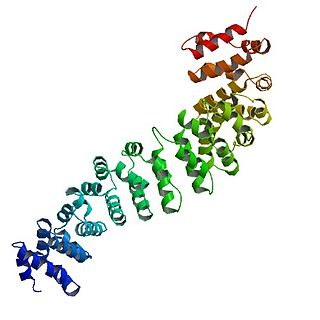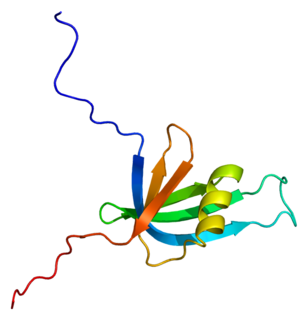Related Research Articles

Transcription is the process of copying a segment of DNA into RNA. The segments of DNA transcribed into RNA molecules that can encode proteins are said to produce messenger RNA (mRNA). Other segments of DNA are copied into RNA molecules called non-coding RNAs (ncRNAs). Averaged over multiple cell types in a given tissue, the quantity of mRNA is more than 10 times the quantity of ncRNA. The general preponderance of mRNA in cells is valid even though less than 2% of the human genome can be transcribed into mRNA, while at least 80% of mammalian genomic DNA can be actively transcribed, with the majority of this 80% considered to be ncRNA.

Histone acetyltransferases (HATs) are enzymes that acetylate conserved lysine amino acids on histone proteins by transferring an acetyl group from acetyl-CoA to form ε-N-acetyllysine. DNA is wrapped around histones, and, by transferring an acetyl group to the histones, genes can be turned on and off. In general, histone acetylation increases gene expression.

The origin of replication is a particular sequence in a genome at which replication is initiated. Propagation of the genetic material between generations requires timely and accurate duplication of DNA by semiconservative replication prior to cell division to ensure each daughter cell receives the full complement of chromosomes. This can either involve the replication of DNA in living organisms such as prokaryotes and eukaryotes, or that of DNA or RNA in viruses, such as double-stranded RNA viruses. Synthesis of daughter strands starts at discrete sites, termed replication origins, and proceeds in a bidirectional manner until all genomic DNA is replicated. Despite the fundamental nature of these events, organisms have evolved surprisingly divergent strategies that control replication onset. Although the specific replication origin organization structure and recognition varies from species to species, some common characteristics are shared.
RSC is a member of the ATP-dependent chromatin remodeler family. The activity of the RSC complex allows for chromatin to be remodeled by altering the structure of the nucleosome.

Catenin beta-1, also known as β-catenin, is a protein that in humans is encoded by the CTNNB1 gene.
In molecular biology, origin recognition complex (ORC) is a multi-subunit DNA binding complex that binds in all eukaryotes and archaea in an ATP-dependent manner to origins of replication. The subunits of this complex are encoded by the ORC1, ORC2, ORC3, ORC4, ORC5 and ORC6 genes. ORC is a central component for eukaryotic DNA replication, and remains bound to chromatin at replication origins throughout the cell cycle.

Eukaryotic DNA replication is a conserved mechanism that restricts DNA replication to once per cell cycle. Eukaryotic DNA replication of chromosomal DNA is central for the duplication of a cell and is necessary for the maintenance of the eukaryotic genome.
Chromatin remodeling is the dynamic modification of chromatin architecture to allow access of condensed genomic DNA to the regulatory transcription machinery proteins, and thereby control gene expression. Such remodeling is principally carried out by 1) covalent histone modifications by specific enzymes, e.g., histone acetyltransferases (HATs), deacetylases, methyltransferases, and kinases, and 2) ATP-dependent chromatin remodeling complexes which either move, eject or restructure nucleosomes. Besides actively regulating gene expression, dynamic remodeling of chromatin imparts an epigenetic regulatory role in several key biological processes, egg cells DNA replication and repair; apoptosis; chromosome segregation as well as development and pluripotency. Aberrations in chromatin remodeling proteins are found to be associated with human diseases, including cancer. Targeting chromatin remodeling pathways is currently evolving as a major therapeutic strategy in the treatment of several cancers.

RuvB-like 2 , also known as RUVBL2, is a human gene coding for a protein belonging to the AAA+ family of proteins.

RuvB-like 1 , also known as RUVBL1 and TIP49, is a human gene. RUVBL1 can form a hexamer. The hexamer can form a dodecamer with RUVBL2 protein. Possesses single-stranded DNA-stimulated ATPase and ATP-dependent DNA helicase activity; hexamerization is thought to be critical for ATP hydrolysis and adjacent subunits in the ring-like structure contribute to the ATPase activity.

DNA excision repair protein ERCC-6 is a protein that in humans is encoded by the ERCC6 gene. The ERCC6 gene is located on the long arm of chromosome 10 at position 11.23.

Helicase-like transcription factor is an enzyme that in humans is encoded by the HLTF gene.

The Chromodomain-Helicase DNA-binding 1 is a protein that, in humans, is encoded by the CHD1 gene. CHD1 is a chromatin remodeling protein that is widely conserved across many eukaryotic organisms, from yeast to humans. CHD1 is named for three of its protein domains: two tandem chromodomains, its ATPase catalytic domain, and its DNA-binding domain.

Chromodomain-helicase-DNA-binding protein 8 is an enzyme that in humans is encoded by the CHD8 gene.
The TCF/LEF family is a group of genes that encode transcription factors which bind to DNA through a SOX-like high mobility group domain. They are involved in the Wnt signaling pathway, particularly during embryonic and stem-cell development, but also had been found to play a role in cancer and diabetes. TCF/LEF factors recruit the coactivator beta-catenin to enhancer elements of genes they target. They can also recruit members of the Groucho family of corepressors.
Telomere-binding proteins function to bind telomeric DNA in various species. In particular, telomere-binding protein refers to TTAGGG repeat binding factor-1 (TERF1) and TTAGGG repeat binding factor-2 (TERF2). Telomere sequences in humans are composed of TTAGGG sequences which provide protection and replication of chromosome ends to prevent degradation. Telomere-binding proteins can generate a T-loop to protect chromosome ends. TRFs are double-stranded proteins which are known to induce bending, looping, and pairing of DNA which aids in the formation of T-loops. They directly bind to TTAGGG repeat sequence in the DNA. There are also subtelomeric regions present for regulation. However, in humans, there are six subunits forming a complex known as shelterin.
Shelterin is a protein complex known to protect telomeres in many eukaryotes from DNA repair mechanisms, as well as to regulate telomerase activity. In mammals and other vertebrates, telomeric DNA consists of repeating double-stranded 5'-TTAGGG-3' (G-strand) sequences along with the 3'-AATCCC-5' (C-strand) complement, ending with a 50-400 nucleotide 3' (G-strand) overhang. Much of the final double-stranded portion of the telomere forms a T-loop (Telomere-loop) that is invaded by the 3' (G-strand) overhang to form a small D-loop (Displacement-loop).

Homeobox containing 1, also known as homeobox telomere-binding protein 1 (HOT1), is a protein that in humans is encoded by the HMBOX1 gene. HMBOX1 directly binds to the double-stranded repeat sequence of telomeres.
The NuA4 histone acetyltransferase complex is a protein complex that has histone acetylase activity on chromatin, as well as ATPase, DNA helicase and structural DNA binding activities. The complex is thought to be involved in double-strand DNA break repair. Subunits of the human complex include HTATIP/TIP60, TRRAP, RUVBL1, RUVBL2, beta-actin and BAF53/ACTL6A. In yeast, the complex has 13 subunits, including the catalytic subunit Esa1.
The INO80 subfamily of chromatin remodeling complexes are ATPases, and includes the INO80 and SWR1 complexes.
References
- ↑ Matias, PM; Baek, SH; Bandeiras, TM; Dutta, A; Houry, WA; Llorca, O; Rosenbaum, J (2015). "The AAA+ proteins Pontin and Reptin enter adult age: from understanding their basic biology to the identification of selective inhibitors". Frontiers in Molecular Biosciences. 2: 17. doi: 10.3389/fmolb.2015.00017 . PMC 4428354 . PMID 25988184.
- 1 2 3 4 Weiske, Jörg; Huber, Otmar (2005-07-15). "The histidine triad protein Hint1 interacts with Pontin and Reptin and inhibits TCF–β-catenin-mediated transcription". Journal of Cell Science. 118 (14): 3117–3129. doi: 10.1242/jcs.02437 . ISSN 0021-9533. PMID 16014379.
- 1 2 Park, Eun-Jung; Hur, Shin-Kyoung; Kwon, Jongbum (2010-10-15). "Human INO80 chromatin-remodelling complex contributes to DNA double-strand break repair via the expression of Rad54B and XRCC3 genes". Biochemical Journal. 431 (2): 179–187. doi:10.1042/BJ20100988. ISSN 0264-6021. PMID 20687897.
- ↑ Queval, Richard; Papin, Christophe; Dalvai, Mathieu; Bystricky, Kerstin; Humbert, Odile (2014-12-05). "Reptin and Pontin Oligomerization and Activity Are Modulated through Histone H3 N-terminal Tail Interaction". Journal of Biological Chemistry. 289 (49): 33999–34012. doi: 10.1074/jbc.M114.576785 . ISSN 0021-9258. PMC 4256336 . PMID 25336637.
- ↑ "RUVBL2 - RuvB-like 2 - Homo sapiens (Human) - RUVBL2 gene & protein". www.uniprot.org. Retrieved 2016-11-06.
- ↑ Gribun, Anna; Cheung, Kevin L. Y.; Huen, Jennifer; Ortega, Joaquin; Houry, Walid A. (2008-03-07). "Yeast Rvb1 and Rvb2 are ATP-Dependent DNA Helicases that Form a Heterohexameric Complex". Journal of Molecular Biology. 376 (5): 1320–1333. doi:10.1016/j.jmb.2007.12.049. PMID 18234224.
- ↑ Gallant, Peter (2007). "Control of Transcription by Pontin and Reptin" (PDF). Trends in Cell Biology. 17 (4, 187–192): 187–192. doi:10.1016/j.tcb.2007.02.005. PMID 17320397.
- ↑ Venteicher, Andrew S.; Meng, Zhaojing; Mason, Philip J.; Veenstra, Timothy D.; Artandi, Steven E. (2008-03-21). "Identification of ATPases pontin and reptin as telomerase components essential for holoenzyme assembly". Cell. 132 (6): 945–957. doi:10.1016/j.cell.2008.01.019. ISSN 0092-8674. PMC 2291539 . PMID 18358808.
- ↑ Maslon, Magdalena M.; Hrstka, Roman; Vojtesek, Borek; Hupp, Ted R. (2010-12-03). "A Divergent Substrate-Binding Loop within the Pro-oncogenic Protein Anterior Gradient-2 Forms a Docking Site for Reptin". Journal of Molecular Biology. 404 (3): 418–438. doi:10.1016/j.jmb.2010.09.035. hdl: 1842/6477 . PMID 20888340.
- ↑ Healy, Alan R.; Houston, Douglas R.; Remnant, Lucy; Huart, Anne-Sophie; Brychtova, Veronika; Maslon, Magda M.; Meers, Olivia; Muller, Petr; Krejci, Adam (2015-04-20). "Discovery of a novel ligand that modulates the protein–protein interactions of the AAA+ superfamily oncoprotein reptin". Chemical Science. 6 (5): 3109–3116. doi: 10.1039/c4sc03885a . ISSN 2041-6539. PMC 5490336 . PMID 28706685.
- 1 2 3 Bauer, Andreas; Chauvet, Sophie (2000). "Pontin52 and Reptin52 function as antagonistic regulators of β-catenin signalling activity". The EMBO Journal. 19 (22): 6121–6130. doi:10.1093/emboj/19.22.6121. PMC 305835 . PMID 11080158.
- 1 2 3 Rosenbaum, Jean; Baek, Sung Hee; Dutta, Anindya; Houry, Walid A.; Huber, Otmar; Hupp, Ted R.; Matias, Pedro M. (2013-03-12). "The Emergence of the Conserved AAA ATPases Pontin and Reptin on the Signaling Landscape". Science Signaling. 6 (266): mr1. doi:10.1126/scisignal.2003906. PMC 4201591 . PMID 23482663.
- ↑ Jacquet, Karine; Fradet-Turcotte, Amélie; Avvakumov, Nikita; Lambert, Jean-Philippe; Roques, Céline; Pandita, Raj K.; Paquet, Eric; Herst, Pauline; Gingras, Anne-Claude (2016-05-05). "The TIP60 complex regulates bivalent chromatin recognition by 53BP1 through direct H4K20me binding and H2AK15 acetylation". Molecular Cell. 62 (3): 409–421. doi:10.1016/j.molcel.2016.03.031. ISSN 1097-2765. PMC 4887106 . PMID 27153538.
- ↑ Qi, Dai; Jin, Haining; Lilja, Tobias; Mannervik, Mattias (2016-11-07). "Drosophila Reptin and Other TIP60 Complex Components Promote Generation of Silent Chromatin". Genetics. 174 (1): 241–251. doi:10.1534/genetics.106.059980. ISSN 0016-6731. PMC 1569795 . PMID 16816423.
- ↑ Stolc, Viktor; et al. (2005). "Genome-wide transcriptional analysis of flagellar regeneration in Chlamydomonas reinhardtii identifies orthologs of ciliary disease genes". PNAS. 102 (10): 3703–3707. Bibcode:2005PNAS..102.3703S. doi: 10.1073/pnas.0408358102 . PMC 553310 . PMID 15738400.
- ↑ Zhao, Lu; Yuan, Shiaulou; Cao, Ying; Kallakuri, Sowjanya; Li, Yuanyuan; Kishimoto, Norihito; DiBella, Linda; Sun, Zhaoxia (2013-07-30). "Reptin/Ruvbl2 is a Lrrc6/Seahorse interactor essential for cilia motility". Proceedings of the National Academy of Sciences of the United States of America. 110 (31): 12697–12702. Bibcode:2013PNAS..11012697Z. doi: 10.1073/pnas.1300968110 . ISSN 0027-8424. PMC 3732945 . PMID 23858445.
- 1 2 Kakihara, Yoshito; Houry, Walid A. (2012-01-01). "The R2TP complex: Discovery and functions". Biochimica et Biophysica Acta (BBA) - Molecular Cell Research. AAA ATPases: structure and function. 1823 (1): 101–107. doi: 10.1016/j.bbamcr.2011.08.016 . PMID 21925213.
- Kim, Jung Hwa; Choi, Hee June; Kim, Bogyou; Kim, Mi Hyang; Lee, Ji Min; Kim, Ik Soo; Lee, Moon Hee; Choi, Soo Joon; Kim, Keun Il; Kim, Su-Il; Chung, Chin Ha; Baek, Sung Hee (2006). "Roles of sumoylation of a reptin chromatin-remodelling complex in cancer metastasis". Nature Cell Biology. 8 (6): 631–9. doi:10.1038/ncb1415. PMID 16699503. S2CID 36037879.